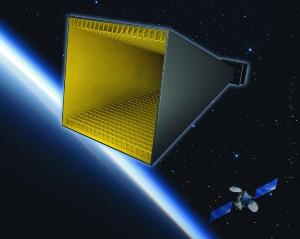Jan 31 2011
Cheaper, lighter and more energy-efficient broadband devices on communications satellites may be possible using metamaterials to modify horn antennas, according to engineers from Penn State and Lockheed Martin Corp.
"Existing horn antennas have adequate performance, but have undergone little change over several decades except for advances in more accurate modeling techniques," said Erik Lier, technical Fellow, Lockheed Martin Space Systems Co. "Modifications enabled by metamaterials can either enhance performance, or they can lower the mass and thus lower the cost of putting the antenna in space."
 3-dimentional rendering of metamaterial lined feed horn antenna with low loss, low weight, and over an octave bandwidth for satellite communications shown with satellite.
3-dimentional rendering of metamaterial lined feed horn antenna with low loss, low weight, and over an octave bandwidth for satellite communications shown with satellite.
Lighter antennas cost less to boost into space and more energy-efficient antennas can reduce the size of storage batteries and solar cells, which also reduces the mass.
Metamaterials derive their unusual properties from structure rather than composition and possess exotic properties not usually found in nature.
"Working with Penn State, we decided that the first year we were going focus on applications for radio frequency antennas, where we thought we had a reasonable chance to succeed," said Lier.
According to Douglas H. Werner, professor of electrical engineering, Penn State, this is one of the first practical implementations of electromagnetic metamaterials that makes a real world device better.
"These results also help lay to rest the widely held viewpoint that metamaterials are primarily an academic curiosity and, due to their narrow bandwidth and relatively high loss, will never find their way into real-world devices," the researchers report in the current issue of Nature Materials.
They specifically designed their electromagnetic metamaterials to avoid previous limitations of narrow bandwidth and high intrinsic material loss, which results in signal loss. Their aim was not to design theoretical metamaterial-enhanced antennas, but to build a working prototype.
"We have developed design optimization tools that can be employed to meet real device requirements," said Werner. "We can optimize the metamaterial to get the best device performance by tailoring its properties across a desired bandwidth to meet the specific needs of the horn antenna."
The researchers wanted an antenna that could work over a broad band of frequencies -- at least an octave -- and improve upon existing antennas. An octave in the radio frequency spectrum is a stretch of bandwidth where the upper frequency is twice the lower frequency -- 3.5 to 7 gigahertz for example, which is wider than the standard C-band.
Horn antennas are part of communications satellites that relay television and radio signals, telephone calls and data around the world. Two commonly used microwave bands on satellites are C-band -- used for long-distance radio and telecommunications -- and Ku-band -- used for broadcast television and remote television uplinks.
The researchers, who also included Qi Wu and Jeremy A. Bossard, postdoctoral fellows in electrical engineering, and Clinton P. Scarborough, graduate student, electrical engineering, all from Penn State, designed horn antenna liners from metamaterials with special low-index electromagnetic properties -- effective refractive index between zero and one -- which do not physically exist in natural materials. To increase bandwidth and decrease loss, the antenna liners needed to have repetitive structure considerably smaller than the wavelengths the antenna is designed to transmit.
Ku-band -- 12 to 18 gigahertz -- antennas require small structural intervals that are easily fabricated using conventional printed circuit board manufacturing techniques, while super extended C-band -- 3.4 to 6.725 gigahertz -- could be achieved with a simple wire grid structure that is easily manufactured with an interval of about a quarter of an inch between wires. The researchers chose to convert the C-band application into a prototype.
"This is just an example of what we can do," said Lier. "It opens up the way for a broader range of other applications and is proof of the new metamaterial technology and an example of how it can be used."
The Lockheed Martin University Research Initiative program funded this project.